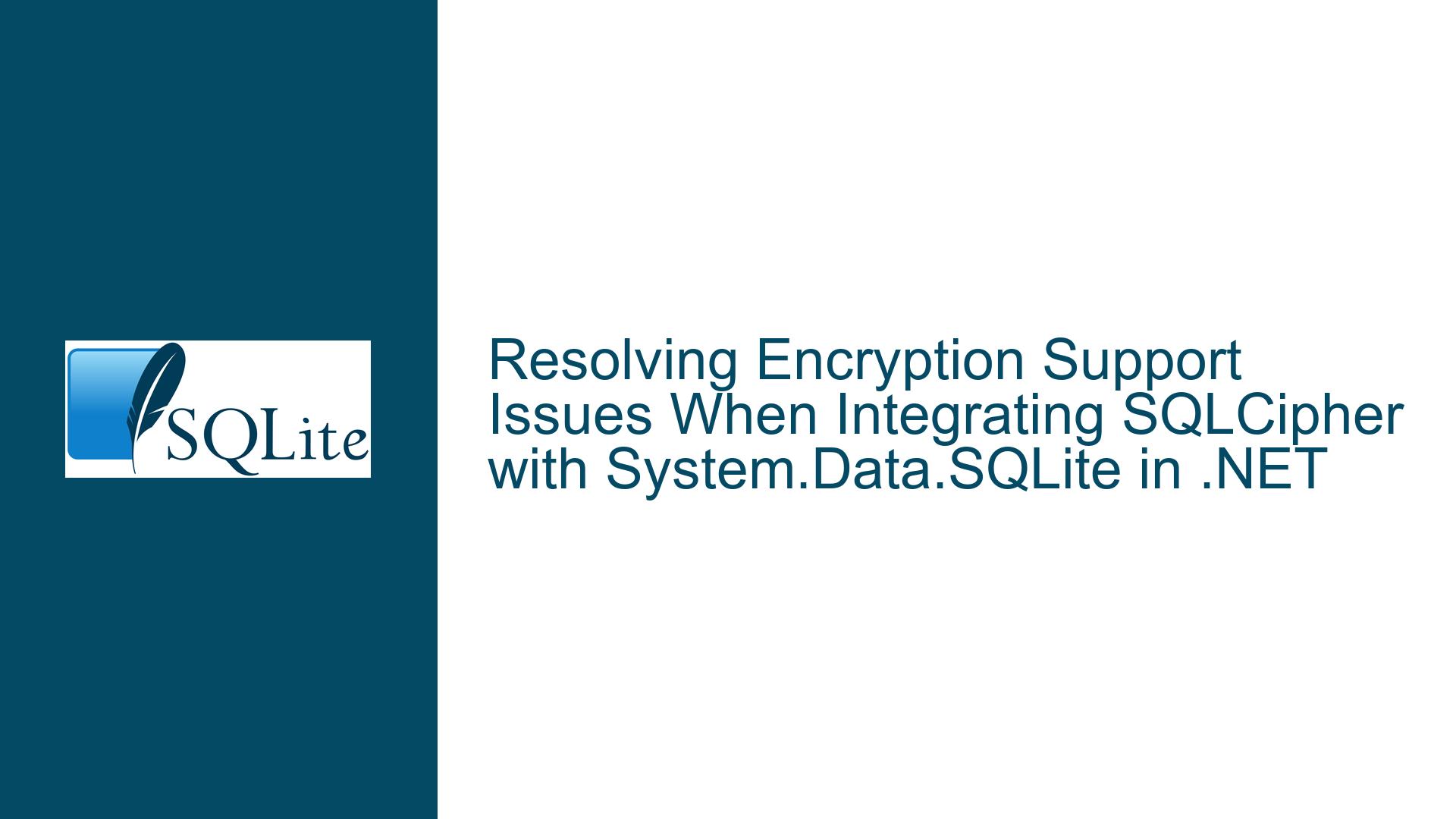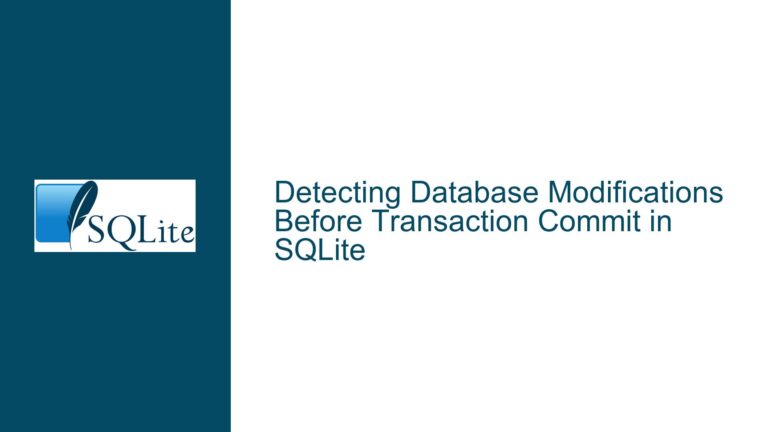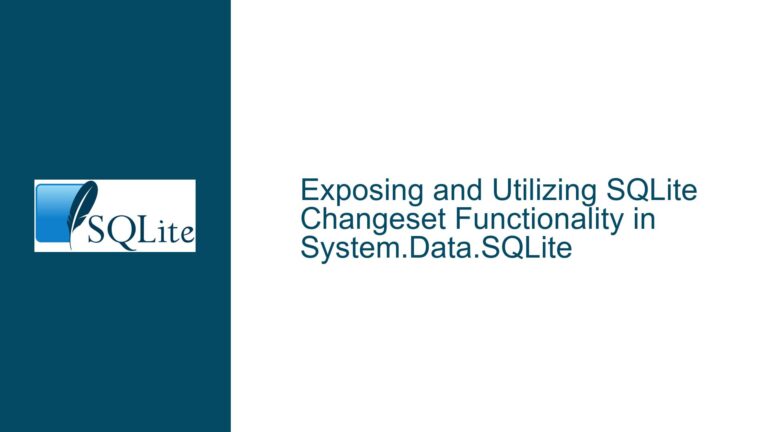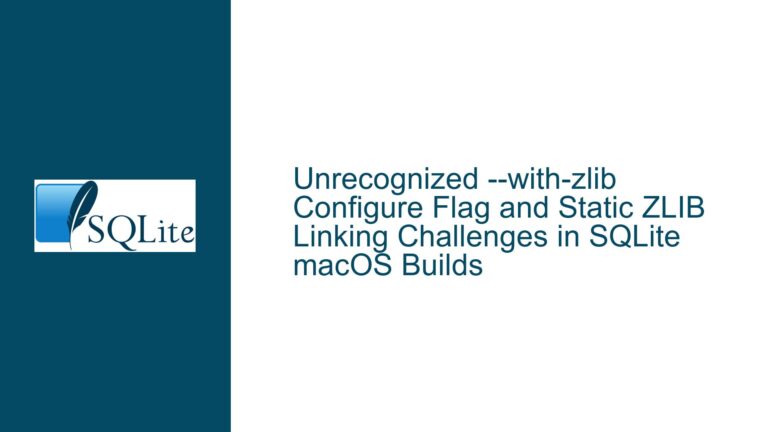Resolving Encryption Support Issues When Integrating SQLCipher with System.Data.SQLite in .NET
Understanding the Encryption Support Error in System.Data.SQLite with Custom SQLCipher DLLs
The core challenge revolves around integrating a self-compiled SQLCipher DLL with the System.Data.SQLite library in a .NET Framework 4.8 C# project. The goal is to enable database encryption via the connection.SetPassword() method, but attempts to do so result in an exception: "the library was not built with encryption support." This error is ambiguous—it could refer to either the SQLite3 DLL (SQLCipher) or the System.Data.SQLite wrapper lacking encryption capabilities. The project has additional constraints: compatibility with 32-bit systems, avoidance of Apache-licensed dependencies (e.g., SQLitePCL.raw), and a preference for cost-effective solutions over purchasing SQLite Encryption Extension (SEE) licenses. The discussion highlights confusion about build configurations, licensing conflicts, and the feasibility of using precompiled binaries versus custom builds.
Key technical components involved:
- System.Data.SQLite: The .NET library that acts as an ADO.NET provider for SQLite.
- SQLCipher: A modified SQLite version with built-in encryption support.
- SQLite3.dll: The native SQLite library (or SQLCipher variant) that System.Data.SQLite interacts with.
The error arises because encryption features in System.Data.SQLite require both the native SQLite3.dll and the .NET wrapper to be compiled with encryption support. Precompiled System.Data.SQLite binaries from the official repository lack encryption support by default, as they link to a vanilla SQLite3.dll. Even if a custom SQLCipher DLL is substituted, the System.Data.SQLite wrapper must still include code to invoke encryption APIs (e.g., sqlite3_key or sqlite3_rekey). This interdependency is not well-documented, leading to frustration when swapping DLLs fails to resolve the error.
Root Causes of the Encryption Support Exception and Licensing Constraints
1. Precompiled System.Data.SQLite Binaries Lack Encryption Hooks
The official System.Data.SQLite NuGet packages and downloads are built without encryption-related compile-time flags. For example, the INTEROP_CODEC symbol, which enables methods like SetPassword(), is not defined in these builds. Even if a custom SQLCipher DLL is used, the System.Data.SQLite assembly lacks the necessary code to invoke encryption functions. This creates a mismatch: the native DLL supports encryption, but the .NET layer cannot communicate with those features.
2. Licensing Conflicts with Third-Party Dependencies
The SQLitePCL.raw library, which simplifies SQLCipher integration in .NET, is rejected due to its Apache 2.0 license. Although permissive, the Apache license requires attribution and may conflict with organizational policies for proprietary projects. This forces reliance on lower-level solutions like direct P/Invoke calls or custom builds of System.Data.SQLite, which introduces complexity.
3. Incorrect Build Configuration for SQLCipher and System.Data.SQLite
SQLCipher requires specific compile-time options (e.g., SQLITE_HAS_CODEC, SQLITE_TEMP_STORE=2) to enable encryption. If these are missing, the resulting DLL will behave like vanilla SQLite. Similarly, building System.Data.SQLite from source demands precise symbols (e.g., INTEROP_INCLUDE_SEE, INTEROP_CODEC) to include encryption support. Misconfigurations in either component will perpetuate the error.
4. Ambiguity in Error Messaging
The exception message "library was not built with encryption support" does not clarify whether the issue lies in the native SQLite3.dll or the System.Data.SQLite assembly. This ambiguity complicates troubleshooting, as developers may incorrectly assume that replacing the DLL alone suffices.
Step-by-Step Solutions for Enabling Encryption in System.Data.SQLite with SQLCipher
1. Compile System.Data.SQLite from Source with Encryption Support
Why This Works: System.Data.SQLite must include code to interact with SQLCipher’s encryption APIs. Building it from source allows enabling the required compile-time flags.
Steps:
- Clone the Repository: Download the System.Data.SQLite source code from GitHub.
- Configure Encryption Symbols:
- Open
SQLite.Interop.csproj(located insrc\System.Data.SQLite). - Add
<DefineConstants>INTEROP_CODEC;INTEROP_INCLUDE_SEE</DefineConstants>to the<PropertyGroup>section. - Ensure
SQLITE_HAS_CODECis defined in the SQLite amalgamation code (if using a custom SQLCipher build).
- Open
- Replace SQLite Amalgamation:
- Replace the default
sqlite3.candsqlite3.hfiles insrc\SQLite.Interop\with the SQLCipher amalgamation files. - Verify that SQLCipher’s
sqlite3.cincludes#define SQLITE_HAS_CODEC 1and other encryption-related settings.
- Replace the default
- Build for 32-Bit Compatibility:
- Use Visual Studio’s Configuration Manager to target
x86. - Ensure all dependencies (e.g., OpenSSL for SQLCipher) are compiled for 32-bit.
- Use Visual Studio’s Configuration Manager to target
- Reference the Custom Build:
- Replace the precompiled System.Data.SQLite NuGet package with the custom-built DLL.
Verification:
After compiling, inspect the SQLiteConnection class for the SetPassword() method using a decompiler like ILSpy. If present, the encryption hooks are enabled.
2. Build SQLCipher Correctly for System.Data.SQLite Compatibility
Common Pitfalls:
- Missing
SQLITE_HAS_CODECorSQLITE_TEMP_STORE=2in SQLCipher’s build. - Linking against incompatible OpenSSL versions.
Steps:
- Download SQLCipher Source: Clone Zetetic’s SQLCipher repository.
- Configure for 32-Bit:
./configure --enable-tempstore=yes CFLAGS="-DSQLITE_HAS_CODEC" --host=i686-w64-mingw32 - Integrate OpenSSL:
- Link against a 32-bit OpenSSL build. Use
--with-crypto-lib=nonefor no external crypto (not recommended).
- Link against a 32-bit OpenSSL build. Use
- Compile:
make clean make - Replace
sqlite3.dll: Ensure the output DLL is placed alongside the application executable.
3. Resolve Licensing Constraints via Commercial Licensing or Alternatives
Options:
- Purchase SQLCipher Commercial License: Zetetic offers commercial licenses for SQLCipher, resolving Apache license conflicts.
- Use SQLite Encryption Extension (SEE): Purchase SEE from SQLite.org. This avoids third-party dependencies and simplifies integration.
- Evaluate sqlite3mc: A multi-cipher extension with LGPL licensing. Rebuild System.Data.SQLite with sqlite3mc’s amalgamation.
Steps for SEE Integration:
- Acquire SEE Amalgamation: Purchase SEE and obtain
sqlite3-see.candsqlite3-see.h. - Rebuild System.Data.SQLite:
- Replace
sqlite3.cwithsqlite3-see.cin the System.Data.SQLite source. - Define
INTEROP_INCLUDE_SEEin the project.
- Replace
- Call
sqlite3_activate_see(): Initialize SEE in the application startup code.
4. Debugging and Validating the Build
Diagnostic Checks:
- Check SQLite Version: Execute
SELECT sqlite_version();to confirm SQLCipher/SEE is loaded. - Test Encryption:
using (var conn = new SQLiteConnection("Data Source=test.db")) { conn.SetPassword("password"); conn.Open(); // Creates an encrypted database } - Verify DLL Load Order: Use ProcMon to ensure the correct
sqlite3.dllis loaded.
Troubleshooting Failures:
- Exception on
SetPassword(): Indicates missingINTEROP_CODECin System.Data.SQLite. - Database Not Encrypted: The SQLCipher DLL is not correctly built or is not being loaded.
Conclusion
Achieving encryption in System.Data.SQLite with a custom SQLCipher DLL requires meticulous attention to build configurations for both the native library and the .NET wrapper. Precompiled binaries will not suffice due to missing encryption hooks. While building from source is technically demanding, it is unavoidable in scenarios constrained by licensing or legacy systems. For organizations prioritizing time over cost, purchasing SEE or SQLCipher commercial licenses offers a turnkey solution. Developers must weigh the trade-offs between technical effort, compliance, and budgetary constraints to select the optimal path.






